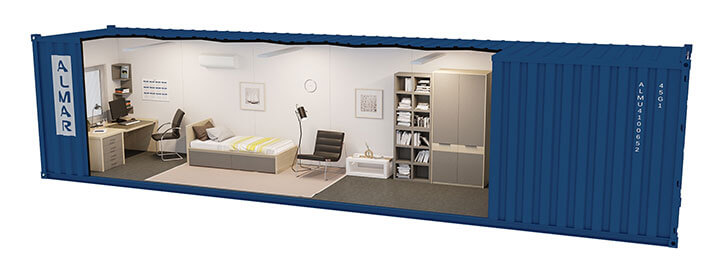There is no doubt that the popularity of steel shipping containers for offices and accommodation is growing rapidly. But are container conversions prices really a lot less than the costs involved in traditional construction methods?
Generally, shipping container conversions are cost-effective and they are a lot quicker to complete than traditional structures, particularly buildings made with bricks or blocks and mortar. They don’t require extensive foundations and are particularly useful on sloping land where traditional housing becomes expensive. So yes, shipping container conversions prices are lower than regular buildings – unless the finishes and fittings used are very expensive.
They also have their own unique advantages.
For instance, steel shipping containers are exceptionally strong and durable and will last a very long time. They are generally resistant to fire, mould, and bugs like termites which is favourable when assessing container conversions prices.
Units can be converted in a factory and delivered to site for completion. This might include cladding and roofing as well as connection to water supply and electricity. It can take as little as three weeks to fabricate in a factory environment. Completion time will depend on the complexity of the design and whether steel reinforcement and/or welding is required.



The first of London’s famous container cities was erected in the Docklands in 2001, and it took only five months for the developers to complete 12 work studios in the three-storey structure. Soon after, a fourth floor comprising apartments and studios was added.
Another of the advantages of using shipping containers for housing is that, because they are modular, they allow for flexibility and avant-garde creativity. They can be placed alongside one another or stacked, and sides can be removed to increase the dimensions of spaces. Also, it is very easy to combine containers with traditional building materials. Obviously, the more containers that are incorporated in the design, the higher the total shipping container cost will be. But then incorporating traditional building materials will also increase cost, not just of the materials but of on-site labour too.
It is possible to cut costs even more by using old steel shipping containers, although many companies that specialize in container conversions prefer to use new units. That will, of course, also increase the shipping container cost. It is worth noting that London’s Container City was constructed from recycled containers, and recycled materials made up 80 percent of the total building materials used. This reduced the container conversions prices dramatically.
Old shipping containers are often dented and there may be some rust. They might affect their structural integrity. If they have been coated with lead-based paint to protect them from saltwater these surfaces will have to be covered for safety. It is, though, usual for designers to incorporate a new floor, ceiling, and both internal and external wall cladding in converted containers.
It can be difficult to fit extensive heating and cooling systems in shipping container buildings. But if insulation is included at the outset, this needn’t be a problem.

There are a growing number of construction companies in southern Africa that specialise in shipping container conversions. Most will deliver the partially finished containers to the site and then complete the building on site. So the basic shell can be assembled in just one day, while the finishes will take about three months, depending on the design.
Some provide “plug & play” options that may even include furniture. The container building is delivered to site and simply has to be connected to the services including water and electricity.
Almar Container Group offers “plug & play” solutions that are popular for office and accommodation use, particularly in remote areas of Africa and the Middle East. The company also supplies containers to construction companies that specialise in container conversions, including those that manufacture up-market dwellings. Call us today to see how we can help you.